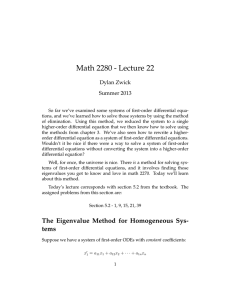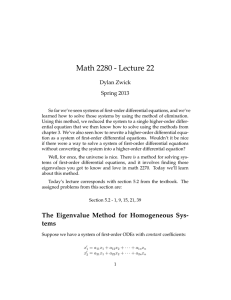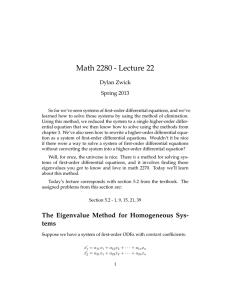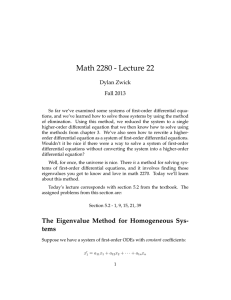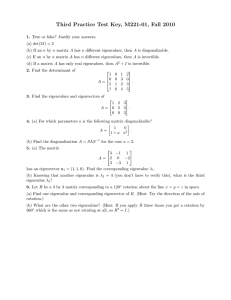Math 2280 - Lecture 22 Dylan Zwick Fall 2013
advertisement
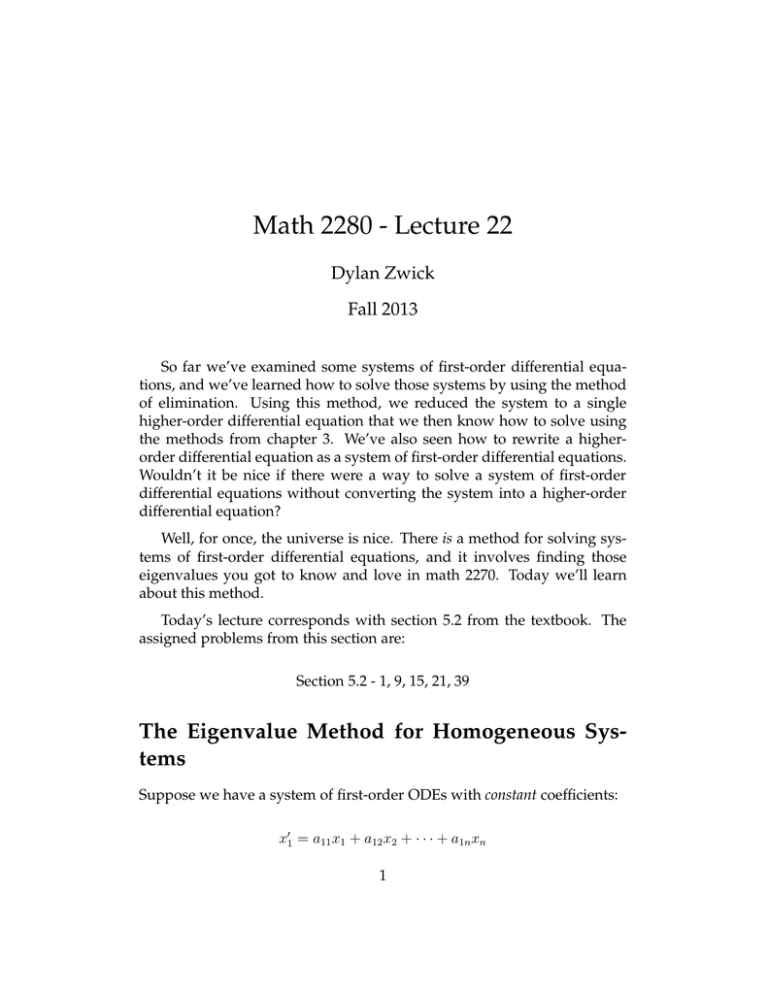
Math 2280 - Lecture 22 Dylan Zwick Fall 2013 So far we’ve examined some systems of first-order differential equations, and we’ve learned how to solve those systems by using the method of elimination. Using this method, we reduced the system to a single higher-order differential equation that we then know how to solve using the methods from chapter 3. We’ve also seen how to rewrite a higherorder differential equation as a system of first-order differential equations. Wouldn’t it be nice if there were a way to solve a system of first-order differential equations without converting the system into a higher-order differential equation? Well, for once, the universe is nice. There is a method for solving systems of first-order differential equations, and it involves finding those eigenvalues you got to know and love in math 2270. Today we’ll learn about this method. Today’s lecture corresponds with section 5.2 from the textbook. The assigned problems from this section are: Section 5.2 - 1, 9, 15, 21, 39 The Eigenvalue Method for Homogeneous Systems Suppose we have a system of first-order ODEs with constant coefficients: x′1 = a11 x1 + a12 x2 + · · · + a1n xn 1 x′2 = a21 x1 + a22 x2 + · · · + a2n xn .. . x′n = an1 x1 + an2 x2 + · · · + ann xn We know that any solution (general theory) can be written as the linear combination: x(t) = c1 x1 + · · · + cn xn where the xi are linearly independent solutions of the system of ODEs. So, what we want to do is figure out how to find these linearly independent solutions. The Exponential “Guess” By analogy with the constant coefficient case for homogeneous ODEs, we can “guess” a solution of the form: v1 x(t) = ... eλt = veλt vn where the vi and λ are appropriate scalar constants. Now, if we write our system as: x′ = Ax, then if x = veλt we get: λveλt = Aveλt ⇒ λv = Av which is the “eigenvalue equation” from linear algebra. 2 The Eigenvalue Equation We begin with a theorem from linear algebra. Namely, that Av = λv for some v 6= 0 if and only if det(A − λI) = 0. This theorem determines the possible values of λ. In general a11 − λ a12 ··· a1n a21 a22 − λ · · · a2n det(A − λI) = .. .. .. . .. . . . an1 an2 · · · ann − λ =0 gives us a “characteristic”1 nth-order (in λ) polynomial whose roots are the acceptable values of λ. Well, if we get n distinct eigenvalues, as these roots are called, then we get n linearly independent solutions, and we’re done. Now, as you might imagine, these solutions may be complex conjugates, a situation we’ll discuss today. We’ll delay what we do if any of the eigenvalues are repeated until next time. All Real Roots If all the roots are real and distinct, then the problem is as easy as it can be. How this is handled is best seen in the context of an example. Example - Find the general solution of: x = ′ 1 2 3 2 1 x The German term “eigen” roughly translates, in this context, as “characteristic”. 3 Room for the solution to the example problem. 4 Complex Eigenvalues Any complex eigenvalue will also have its conjugate as an eigenvalue: (A − λI)v = 0 ⇒ (A − λI)v = 0 So, v is a corresponding eigenvector to the eigenvalue λ. Now, if λ is complex then we have: x(t) = veλt = ve(p+qi)t = (a + bi)ept (cos (qt) + i sin (qt)) which gives us, x(t) = ept (a cos (qt) − b sin (qt)) + iept (b cos (qt) + a sin (qt)) Now, as 0 = 0 + i0, both the real term and complex term here must be a solution to the system of ODEs, and these are the same pair of solutions we’ll get from the eigenvalue’s conjugate. So, our two linearly independent solutions, arising from the eigenvalue and its conjugate, are the real and imaginary parts above. Example - Find the solution to the given system of ODEs: x′1 = x1 − 2x2 x′2 = 2x1 + x2 x1 (0) = 0, x2 (0) = 4 5 Room for the solution to the example problem. 6 Notes on Homework Problems For problems 5.2.1, 5.2.9. amd 5.2.15, you’re solving eigenvalue problems like the examples above. The problems ask you to construct a direction field and plot typical solution curves. You don’t need to spend too much time on this part. A simple sketch is sufficient. For problem 5.2.21 you’re still solving an eigenvalue problem, but this time it’s a 3 × 3 system instead of a 2 × 2 system. Same methods apply, although finding the eigenvalues is a little more work. On the plus side, you don’t have to graph any direction fields! For problem 5.2.39 you want to solve the largest system you’ll see in this class, a 4 × 4 system. As you might imagine, calculating the determinant and finding its roots for a 4 × 4 system is in general a hard problem, but in this case it’s not so bad. The matrix has a lot of zeros, a condition referred to in mathematics as being “sparse”. Calculating determinants of sparse matrices is much easier than calculating determinants of general matrices. 7
